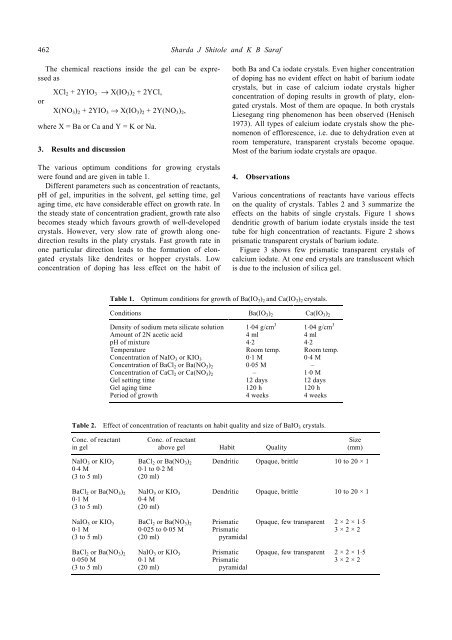Growth and study of some gel grown group II single crystals of iodate
Growth and study of some gel grown group II single crystals of iodate
Growth and study of some gel grown group II single crystals of iodate
Create successful ePaper yourself
Turn your PDF publications into a flip-book with our unique Google optimized e-Paper software.
462<br />
Sharda J Shitole <strong>and</strong> K B Saraf<br />
The chemical reactions inside the <strong>gel</strong> can be expressed<br />
as<br />
or<br />
XCl 2 + 2YIO 3 → X(IO 3 ) 2 + 2YCl,<br />
X(NO 3 ) 2 + 2YIO 3 → X(IO 3 ) 2 + 2Y(NO 3 ) 2 ,<br />
where X = Ba or Ca <strong>and</strong> Y = K or Na.<br />
3. Results <strong>and</strong> discussion<br />
The various optimum conditions for growing <strong>crystals</strong><br />
were found <strong>and</strong> are given in table 1.<br />
Different parameters such as concentration <strong>of</strong> reactants,<br />
pH <strong>of</strong> <strong>gel</strong>, impurities in the solvent, <strong>gel</strong> setting time, <strong>gel</strong><br />
aging time, etc have considerable effect on growth rate. In<br />
the steady state <strong>of</strong> concentration gradient, growth rate also<br />
becomes steady which favours growth <strong>of</strong> well-developed<br />
<strong>crystals</strong>. However, very slow rate <strong>of</strong> growth along onedirection<br />
results in the platy <strong>crystals</strong>. Fast growth rate in<br />
one particular direction leads to the formation <strong>of</strong> elongated<br />
<strong>crystals</strong> like dendrites or hopper <strong>crystals</strong>. Low<br />
concentration <strong>of</strong> doping has less effect on the habit <strong>of</strong><br />
both Ba <strong>and</strong> Ca <strong>iodate</strong> <strong>crystals</strong>. Even higher concentration<br />
<strong>of</strong> doping has no evident effect on habit <strong>of</strong> barium <strong>iodate</strong><br />
<strong>crystals</strong>, but in case <strong>of</strong> calcium <strong>iodate</strong> <strong>crystals</strong> higher<br />
concentration <strong>of</strong> doping results in growth <strong>of</strong> platy, elongated<br />
<strong>crystals</strong>. Most <strong>of</strong> them are opaque. In both <strong>crystals</strong><br />
Liesegang ring phenomenon has been observed (Henisch<br />
1973). All types <strong>of</strong> calcium <strong>iodate</strong> <strong>crystals</strong> show the phenomenon<br />
<strong>of</strong> efflorescence, i.e. due to dehydration even at<br />
room temperature, transparent <strong>crystals</strong> become opaque.<br />
Most <strong>of</strong> the barium <strong>iodate</strong> <strong>crystals</strong> are opaque.<br />
4. Observations<br />
Various concentrations <strong>of</strong> reactants have various effects<br />
on the quality <strong>of</strong> <strong>crystals</strong>. Tables 2 <strong>and</strong> 3 summarize the<br />
effects on the habits <strong>of</strong> <strong>single</strong> <strong>crystals</strong>. Figure 1 shows<br />
dendritic growth <strong>of</strong> barium <strong>iodate</strong> <strong>crystals</strong> inside the test<br />
tube for high concentration <strong>of</strong> reactants. Figure 2 shows<br />
prismatic transparent <strong>crystals</strong> <strong>of</strong> barium <strong>iodate</strong>.<br />
Figure 3 shows few prismatic transparent <strong>crystals</strong> <strong>of</strong><br />
calcium <strong>iodate</strong>. At one end <strong>crystals</strong> are transluscent which<br />
is due to the inclusion <strong>of</strong> silica <strong>gel</strong>.<br />
Table 1. Optimum conditions for growth <strong>of</strong> Ba(IO 3 ) 2 <strong>and</strong> Ca(IO 3 ) 2 <strong>crystals</strong>.<br />
Conditions Ba(IO 3 ) 2 Ca(IO 3 ) 2<br />
Density <strong>of</strong> sodium meta silicate solution 1⋅04 g/cm 3 1⋅04 g/cm 3<br />
Amount <strong>of</strong> 2N acetic acid 4 ml 4 ml<br />
pH <strong>of</strong> mixture 4⋅2 4⋅2<br />
Temperature Room temp. Room temp.<br />
Concentration <strong>of</strong> NaIO 3 or KIO 3 0⋅1 M 0⋅4 M<br />
Concentration <strong>of</strong> BaCl 2 or Ba(NO 3 ) 2 0⋅05 M –<br />
Concentration <strong>of</strong> CaCl 2 or Ca(NO 3 ) 2 – 1⋅0 M<br />
Gel setting time 12 days 12 days<br />
Gel aging time 120 h 120 h<br />
Period <strong>of</strong> growth 4 weeks 4 weeks<br />
Table 2. Effect <strong>of</strong> concentration <strong>of</strong> reactants on habit quality <strong>and</strong> size <strong>of</strong> BaIO 3 <strong>crystals</strong>.<br />
Conc. <strong>of</strong> reactant<br />
in <strong>gel</strong><br />
Conc. <strong>of</strong> reactant<br />
above <strong>gel</strong> Habit Quality<br />
Size<br />
(mm)<br />
NaIO 3 or KIO 3<br />
0⋅4 M<br />
(3 to 5 ml)<br />
BaCl 2 or Ba(NO 3 ) 2<br />
0⋅1 M<br />
(3 to 5 ml)<br />
BaCl 2 or Ba(NO 3 ) 2<br />
0⋅1 to 0⋅2 M<br />
(20 ml)<br />
NaIO 3 or KIO 3<br />
0⋅4 M<br />
(20 ml)<br />
Dendritic Opaque, brittle 10 to 20 × 1<br />
Dendritic Opaque, brittle 10 to 20 × 1<br />
NaIO 3 or KIO 3<br />
0⋅1 M<br />
(3 to 5 ml)<br />
BaCl 2 or Ba(NO 3 ) 2<br />
0⋅025 to 0⋅05 M<br />
(20 ml)<br />
Prismatic<br />
Prismatic<br />
pyramidal<br />
Opaque, few transparent<br />
2 × 2 × 1⋅5<br />
3 × 2 × 2<br />
BaCl 2 or Ba(NO 3 ) 2<br />
0⋅050 M<br />
(3 to 5 ml)<br />
NaIO 3 or KIO 3<br />
0⋅1 M<br />
(20 ml)<br />
Prismatic<br />
Prismatic<br />
pyramidal<br />
Opaque, few transparent<br />
2 × 2 × 1⋅5<br />
3 × 2 × 2
















